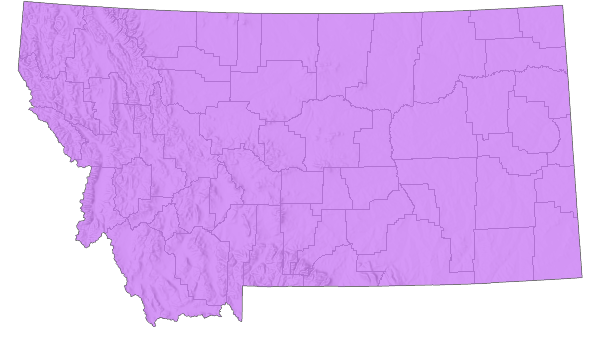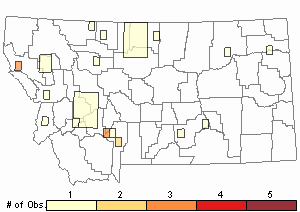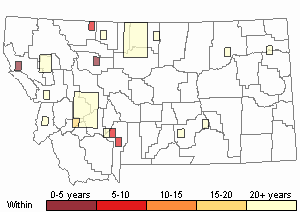View in other NatureServe Network Field Guides
NatureServe
Montana
Utah
Wyoming
Idaho
Wisconsin
British Columbia
South Carolina
Yukon
California
New York
Carolina Grasshopper - Dissosteira carolina
General Description
The following is taken from Hebard (1928), Brooks (1958), Helfer (1971), Otte (1981), Capinera and Sechrist (1982), Vickery and Kevan (1985), McDaniel (1987), Pfadt (2002), Capinera et al. (2004), Brust et al. (2008), and Scott (2010). This species is one of North America’s largest grasshoppers and a strong, adept flier. Their flight is undulating, fluttering, and often consists of right angle turns before landing. They may crepitate* as they fly. They usually fly 1 to 5 feet above the ground, for a distance of 3 to 70 feet. The wings extend well beyond the abdominal tip. The body color can be gray, brown, or reddish with light speckling. It is the only grasshopper species in Montana to have black hind wings with a yellow outer margin. The mid-carina on the pronotum (thorax) is elevated and deeply cut before the middle by one sulcus (groove). The inner face of the hind femur is yellow with black markings and posterior ring. The hind tibia is yellow.
Communicative behavior/Crepitation*
The males are noted for their hovering flight over bare patches of ground. They ascend vertically to heights from 3 to 6 feet, sometimes going upwards to 15 feet above the ground, and hover for up to 15 seconds or longer. During the first half of the flight the wing beats are more rapid than those of the second half. Their crepitation is not as loud as that of Circotettix or Arphia species, but is a soft, hissing sound. After completing a flight, they drop to the ground, landing at the spot where they began their flight. An individual may repeat the flights up to five times. Hovering flights of this species is not as common as those performed by other bandwinged species and one can wait half a day to observe a single flight. The Carolina Grasshopper also uses femur tipping and stridulation* during courtship and aggressive encounters with other males (Otte 1970 and 1984, Vickery and Kevan 1985).
*Crepitation is the sound produced by grasshoppers making a clicking or snapping noise with their wings when in flight, during courtship, territorial encounters or being disturbed.
*Stridulation is rubbing one body part against another, usually the hind femur against the forewing in the case of the Band-winged Grasshoppers. This is often used for attracting a female during courtship (Otte 1970).
Phenology
This species overwinters in the egg stage. Nymphs begin to appear in mid-May. Adults are present from June through mid-October (Otte 1984, Vickery and Kevan 1985, Pfadt 2002, Capinera et al. 2004, and Scott 2010).
Diagnostic Characteristics
The following comes from Hebard (1928), Brooks (1958), Helfer (1971), Otte (1981), Capinera and Sechrist (1982), Vickery and Kevan (1985), McDaniel (1987), Pfadt (2002), Capinera et al. (2004), Brust et al. (2008), and Scott (2010). The body length to the end of the forewings for males is 32-42 mm, and for females 42-58 mm. The male wingspread is 3 inches, and female wingspread is 3.5-4 inches.
This species is not often confused with any other grasshopper species, but in flight it is sometimes mistaken for a butterfly.
Species Range
Montana Range
Range Descriptions

 Native
Native
Range Comments
The Carolina Grasshopper occurs in all of the U.S. states and across the southern latitudes of the Canadian Provinces. In Montana, it has been reported for 48 counties, but most likely occurs statewide. It is probably the most commonly seen and encountered grasshopper within its geographical range. It has been speculated that in pre-civilized times, this species may have been much more limited in its range and may have spread due to human land alterations and disturbances. Much of its extraordinary spread has been provided by our road and highway network providing avenues for colonization, even into forested areas (Hebard 1928, Brooks 1958, Otte 1984, Vickery and Kevan 1985, Pfadt 2002, Capinera et al. 2004, Brust et al. 2008, and Scott 2010).
Observations in Montana Natural Heritage Program Database
Number of Observations: 65
(Click on the following maps and charts to see full sized version)
Map Help and Descriptions
Relative Density

Recency



 (Observations spanning multiple months or years are excluded from time charts)
(Observations spanning multiple months or years are excluded from time charts)
Habitat
The Carolina Grasshopper prefers disturbed sites where there are bare spots of sandy or gravelly soils. It is commonly seen on paved and gravel roads, trails, beaches, sidewalks, parking lots, in suburban yards and driveways, and even city centers. They move from nearby vegetated areas to these barren areas in the heat of the day and conspicuously fly about. Walking a trail, they will often repeatedly fly ahead of one’s approach to a distance of about 3 to 10 feet, land, turn around, and face the intruder. This can go on for several yards walking distance. This is a heat-loving species and on a summer day, one can hardly miss them. (Otte 1984, Vickery and Kevan 1985, Pfadt 2002, Capinera et al. 2004, and Brust et al. 2008).
Food Habits
This species consumes both grasses and forbs. An individual’s diet mostly depends on what food plants are available. Among favored grasses are
Cheatgrass (
Bromus tectorum),
Smooth brome (
Bromus inermis), and
Western wheatgrass (
Elymus smithii). Favored forbs include
Scarlet globemallow (
Sphaeralcea coccinea),
Oppositeleaf false bahia (
Picradeniopsis oppositifolia),
Russian thistle (
Salsola tragus), kochia, and dandelion. Lab tests find this species rejects
White goosefoot (
Chenopodium album),
Redroot amaranth (
Amaranthus retroflexus) and
Curlycup gumweed (
Grindelia squarrosa) (Vickery and Kevan 1985, Pfadt 2002).
Reproductive Characteristics
Males court females by stridulating with their hind femur rubbed against the forewing (tegmina) one leg at a time. He may sit on bare ground in sunlight and stridulate for 5 or more minutes before he attracts a mate. An attracted female walks toward him. When she is within 6 inches, he approaches her and mounts. If he is successful, the pair mate and can remain attached up to 16 hours. The female lays her eggs in sunlit, compacted bare ground, often on the edge of a gravel or dirt road. She works her ovipositor to a depth of 1.5 inches and deposits a large clutch of eggs enclosed in a curved 2-inch-long pod containing 30 to 72 eggs in three or four columns. The eggs are yellow, turning reddish-brown, and measure about 6 mm long, with a diameter of 1.2 mm. The nymphs pass through 5 instars before reaching the adult stage. The nymphal period is 40-55 days, depending on altitude. The nymphs emerge over a two-week period and develop in a habitat mixed with grass, weeds, and numerous bare spots (Capinera and Sechrist 1982, Vickery and Kevan 1985, Pfadt 2002).
Stewardship Responsibility
References
- Literature Cited AboveLegend:
 View Online Publication
View Online Publication Brooks, A.R. 1958. Acridoidea of Southern Alberta, Saskatchewan, and Manitoba (Orthoptera). The Canadian Entomologist (Supplement 9) 90:5-92.
Brooks, A.R. 1958. Acridoidea of Southern Alberta, Saskatchewan, and Manitoba (Orthoptera). The Canadian Entomologist (Supplement 9) 90:5-92. Brust, M.L, W.W. Hoback, and R.J. Wright. 2008. The Grasshoppers of Nebraska. Lincoln, NB: University of Nebraska Extension Service, APHIS.
Brust, M.L, W.W. Hoback, and R.J. Wright. 2008. The Grasshoppers of Nebraska. Lincoln, NB: University of Nebraska Extension Service, APHIS. Capinera, J.L. and T.S. Sechrist. 1982. Grasshoppers of Colorado: Identification, Biology, and Management. Fort Collins, CO: Colorado State University Experiment Station, Bulletin 584S. 161 p.
Capinera, J.L. and T.S. Sechrist. 1982. Grasshoppers of Colorado: Identification, Biology, and Management. Fort Collins, CO: Colorado State University Experiment Station, Bulletin 584S. 161 p. Capinera, J.L., R.D. Scott, and T.J. Walker. 2004. Field Guide to Grasshoppers, Katydids, and Crickets of the United States. Ithaca, NY. Cornell University Press.
Capinera, J.L., R.D. Scott, and T.J. Walker. 2004. Field Guide to Grasshoppers, Katydids, and Crickets of the United States. Ithaca, NY. Cornell University Press. Hebard, M. 1928. The Orthoptera of Montana. Proceedings of the Academy of Natural Sciences of Philadelphia, Vol. 80:211-306.
Hebard, M. 1928. The Orthoptera of Montana. Proceedings of the Academy of Natural Sciences of Philadelphia, Vol. 80:211-306. Helfer, J.R. 1971. How to Know the Grasshoppers, Crickets, Cockroaches, and Their Allies. Revised edition (out of print), Mineola, NY: Dover Publications.
Helfer, J.R. 1971. How to Know the Grasshoppers, Crickets, Cockroaches, and Their Allies. Revised edition (out of print), Mineola, NY: Dover Publications. McDaniel, B. 1987. Grasshoppers of South Dakota. Brookings, SD: South Dakota Agricultural Experiment Station, Bulletin TB 89.
McDaniel, B. 1987. Grasshoppers of South Dakota. Brookings, SD: South Dakota Agricultural Experiment Station, Bulletin TB 89. Otte, Daniel. 1970. A comparative study of communicative behavior in grasshoppers. Miscellaneous Publications, Museum of Zoology, No. 141. Ann Arbor, MI: University of Michigan.
Otte, Daniel. 1970. A comparative study of communicative behavior in grasshoppers. Miscellaneous Publications, Museum of Zoology, No. 141. Ann Arbor, MI: University of Michigan. Otte, Daniel. 1981. The North American Grasshoppers. Volume 1. Acrididae (Gomphocerinae and Acridinae). Harvard University Press. 275 pp.
Otte, Daniel. 1981. The North American Grasshoppers. Volume 1. Acrididae (Gomphocerinae and Acridinae). Harvard University Press. 275 pp. Otte, Daniel. 1984. The North American Grasshoppers Volume II. Acrididae (Oedipodinae). Harvard University Press. 366 pp.
Otte, Daniel. 1984. The North American Grasshoppers Volume II. Acrididae (Oedipodinae). Harvard University Press. 366 pp. Pfadt, R.E. 2002. Field Guide to Common Western Grasshoppers, 3rd edition. Laramie, WY: Wyoming Agricultural Experiment Station, Bulletin 912, modified by S. Schell and S. Schell for electronic publication. Accessed 19 February 2020. http://www.uwyo.edu/entomology/grasshoppers/field-guide/index.html#fieldguidetoc
Pfadt, R.E. 2002. Field Guide to Common Western Grasshoppers, 3rd edition. Laramie, WY: Wyoming Agricultural Experiment Station, Bulletin 912, modified by S. Schell and S. Schell for electronic publication. Accessed 19 February 2020. http://www.uwyo.edu/entomology/grasshoppers/field-guide/index.html#fieldguidetoc Scott, R.D. 2010. Montana Grasshoppers, Katydids, and Crickets A Pictorial Field Guide to the Orthoptera. MagpieMTGraphics, Billings, MT.
Scott, R.D. 2010. Montana Grasshoppers, Katydids, and Crickets A Pictorial Field Guide to the Orthoptera. MagpieMTGraphics, Billings, MT. Vickery, V. R. and D. K. M. Kevan. 1985. The grasshopper, crickets, and related insects of Canada and adjacent regions. Biosystematics Research Institute, Ottawa, Ontario. Publication Number 1777. 918 pp.
Vickery, V. R. and D. K. M. Kevan. 1985. The grasshopper, crickets, and related insects of Canada and adjacent regions. Biosystematics Research Institute, Ottawa, Ontario. Publication Number 1777. 918 pp.
- Additional ReferencesLegend:
 View Online Publication
View Online Publication
Do you know of a citation we're missing? Anderson, N.L. 1962. Grasshopper-vegetation relationships on Montana grasslands. Ph.D Dissertation. Bozeman, Montana: Montana State University. 73 p.
Anderson, N.L. 1962. Grasshopper-vegetation relationships on Montana grasslands. Ph.D Dissertation. Bozeman, Montana: Montana State University. 73 p. Bland, R.G. 2003. The Orthoptera of Michigan—Biology, Keys, and Descriptions of Grasshoppers, Katydids, and Crickets. East Lansing, MI: Michigan State University Extension, Bulletin E-2815. 221 p.
Bland, R.G. 2003. The Orthoptera of Michigan—Biology, Keys, and Descriptions of Grasshoppers, Katydids, and Crickets. East Lansing, MI: Michigan State University Extension, Bulletin E-2815. 221 p. Gillespie, R.L.1992. Dynamics of grasshoppers (Orthoptera: Acrididae) at a rangeland-crop interference. Ph.D. Bozeman, MT: Montana State University. 111 p.
Gillespie, R.L.1992. Dynamics of grasshoppers (Orthoptera: Acrididae) at a rangeland-crop interference. Ph.D. Bozeman, MT: Montana State University. 111 p. Hebard, M. 1932. Notes on Montana Orthoptera. Proceedings of the Academy of Natural Sciences of Philadelphia. V. 84. pp 251-257.
Hebard, M. 1932. Notes on Montana Orthoptera. Proceedings of the Academy of Natural Sciences of Philadelphia. V. 84. pp 251-257. Henry, J.E. 1969. Protozoan and viral pathogens of grasshoppers. Ph.D. Dissertation. Bozeman, MT: Montana State University. 153 p.
Henry, J.E. 1969. Protozoan and viral pathogens of grasshoppers. Ph.D. Dissertation. Bozeman, MT: Montana State University. 153 p. Kirk, K. and C.R. Bomar. 2005. Guide to the grasshoppers of Wisconsin. Madison, WI: Wisconsin Department of Natural Resources, Bureau of Integrated Science Services PUB-SS-1008. 154 p.
Kirk, K. and C.R. Bomar. 2005. Guide to the grasshoppers of Wisconsin. Madison, WI: Wisconsin Department of Natural Resources, Bureau of Integrated Science Services PUB-SS-1008. 154 p. Sater, S. 2022. The insects of Sevenmile Creek, a pictorial guide to their diversity and ecology. Undergraduate Thesis. Helena, MT: Carroll College. 242 p.
Sater, S. 2022. The insects of Sevenmile Creek, a pictorial guide to their diversity and ecology. Undergraduate Thesis. Helena, MT: Carroll College. 242 p. Skinner, K.F. 1995. Plant and grasshopper community composition: indicators & interactions across three spatial scales. M.Sc. Thesis. Bozeman, MT: Montana State University. 144 p.
Skinner, K.F. 1995. Plant and grasshopper community composition: indicators & interactions across three spatial scales. M.Sc. Thesis. Bozeman, MT: Montana State University. 144 p.
- Web Search Engines for Articles on "Carolina Grasshopper"
- Additional Sources of Information Related to "Insects"





